Barclays, one of the largest global financial corporates, has one of the most comprehensive and competitive assessment processes. The first round after the Online Application that a candidate needs to pass is the Barclays Online Aptitude Test.
In this article, we will go through every detail about the Barclays Online Assessment process: from all the tests to how to solve each question type.
What is Barclays online assessment?
Barclays online assessment, also known as Business Insight Stage 1, is a series of interactive aptitude tests to measure candidates’ typical or preferred workings and potential numerical, verbal, and critical reasoning ability.
Barclays often uses a series of psychometric assessment tests provided by Cappfinity - a test provider using strength-based assessments to identify capability and engagement in the workplace. Barclays online assessment consists of 4 aptitude tests:
- Numerical Reasoning Test: assesses candidates’ ability to perform basic calculations based on interpretation of data from tables, charts, figures,...
- Verbal Reasoning Test: assesses candidates’ language-using ability including vocabulary, functional communication, and reading comprehension
- Critical Reasoning Test: assess candidates’ ability to make deductions and evaluate conclusions based on given information.
- Situational Judgement Test: evaluate candidates’ working styles and predict future performance in the workplace.
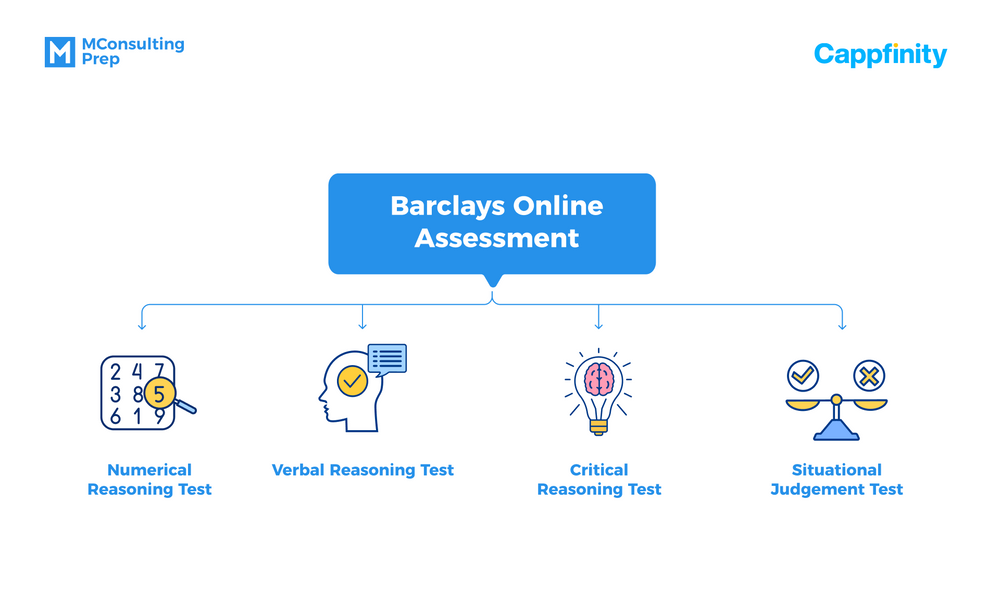
When do you need to take Barclays online assessment?
Online assessment is the second round of Barclays' application screening process, after Online Application Screening. You will receive an email invitation to attend Barclays online assessment if you successfully pass the first round - Online Application Screening.
Barclays Recruitment Process includes 5 stages:
- Round 1: Online Application Screening
- Round 2: Business Insight Stage 1 - Online aptitude test
- Round 3: Business Insight Stage 2 - Technical Test and Video interview
- Round 4: Business Meeting - Barclays Case Study
- Round 5: Final Interview with Line Manager.
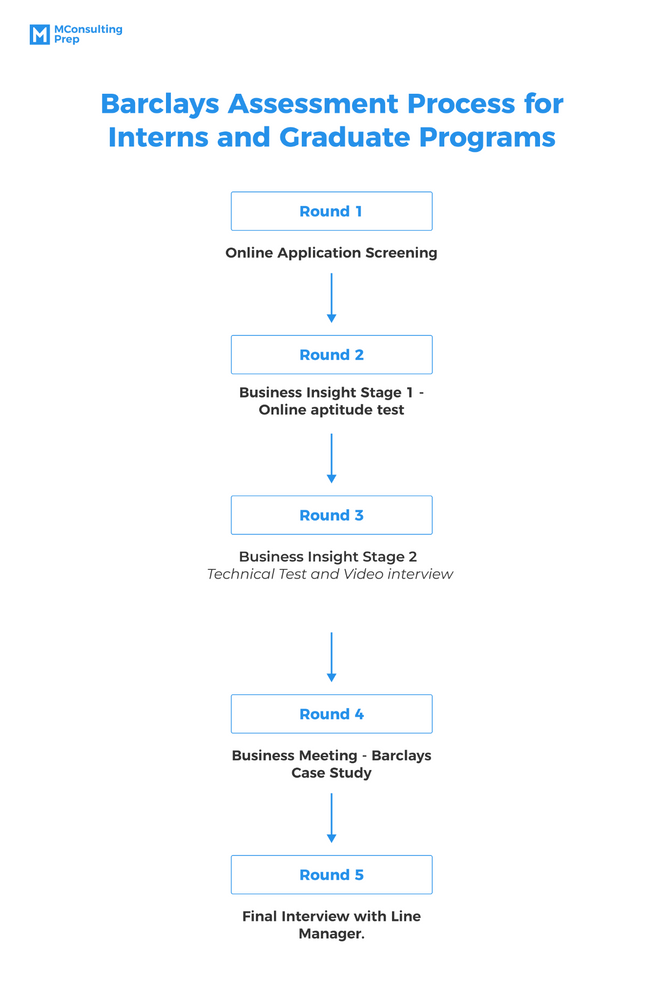
Barclays numerical reasoning test
The Barclays Numerical Reasoning Test aims to evaluate the candidates’ ability to solve numerical problems using basic calculations and data interpretation. This is the most crucial skill for employees of Barclays - a company in the banking and finance field.
The test consists of 35 questions of Data Interpretation, where each question presents a context with a database (tables, charts, etc.) and asks test takers to draw certain inferences based on the data.
The database types that you are likely to encounter are:
- Tables
- Bar charts
- Line charts
- Pie charts
Five steps to solve Barclays numerical reasoning questions
Five simple steps are required when attempting to interpret data and solve the question:
Step 1: Look through the charts quickly to understand the chart type and data type. If there are multiple charts, you must also understand the relationship between the data.
Step 2: Read the question and determine what kind of data you’ll need.
Step 3: Locate the information you need on the table/graph/chart.
Step 4: Apply/Manipulate the data to calculate the answer.
Step 5 (optional): Translate the numerical solution into a meaningful inference if the question requires you.
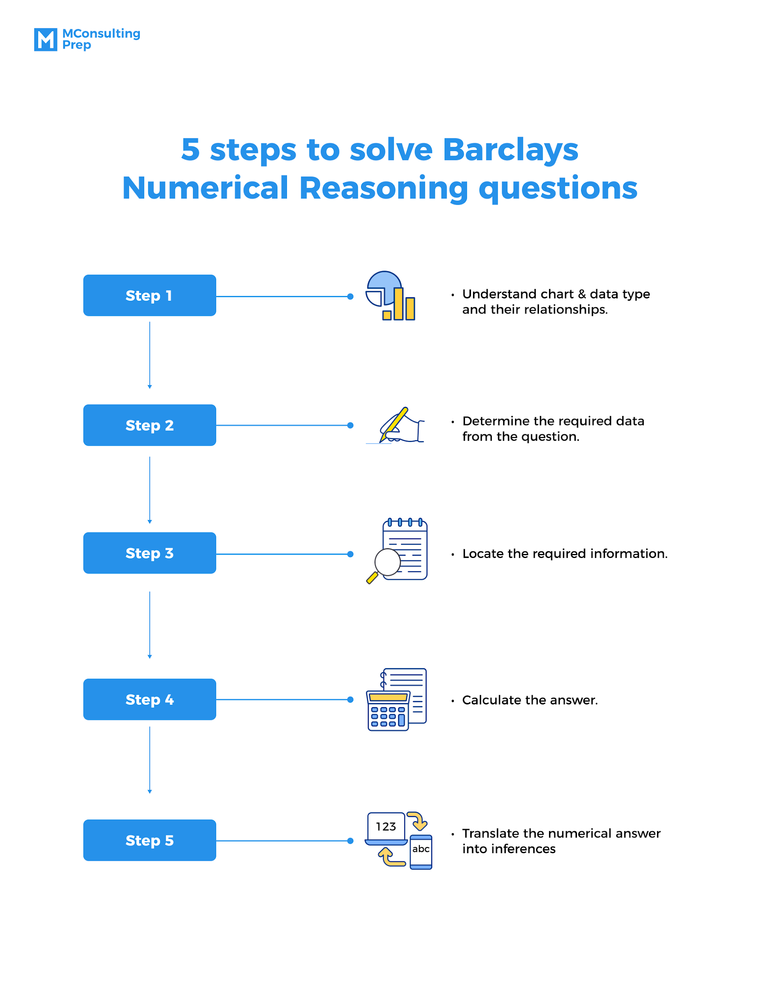
Example questions in the Barclays numerical test
Table Question
This table shows your predicted sales figures for this month and the percentage of these sales expected to come from each department. Halfway through the month, London has only achieved 29% of its target for Beauty.
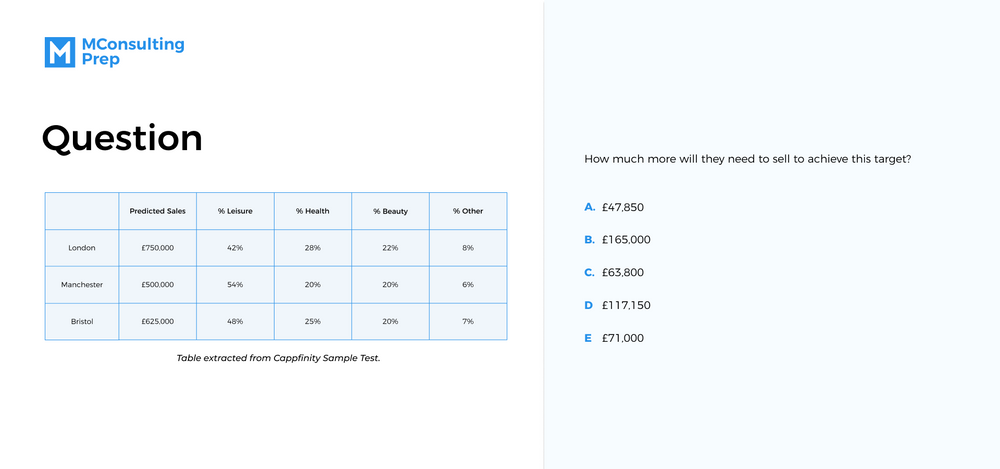
How much more will they need to sell to achieve this target?
A. £47,850
B. £165,000
C. £63,800
D. £117,150
E. £71,000
Answer: D
Explanation:
The table presents the total target sales of a store and the contributing percentages of each department.
Based on the question we would need to calculate the remaining sales target for Beauty Department in the London store.
The total goal for the Beauty department in the London store is 750,000 * 22% = 165,000.
Since they already reached 29% of their plan, the Beauty Department in London store would need to sell the remaining: 100% - 29% = 71%
⇒ Their remaining sales are 165,000 * 71% = 117,150.
The answer is D.
Chart Question
Your Production Director has given you last year's predicted and actual flour production figures from January - April.

Based on the data provided, what was the difference between predicted and actual flour production for January?
Please select your response from the options below.
A. 140.5
B. 187.6
C. 87.6
D. 266
E. 78.9
Answer: B
Explanation:
The chart presents the predicted and actual flour production (in tonnes) for each month from January to April.
The question requires us to look at the data for January.
The gap between predicted and actual production in January is 6500 - 6312.4 = 187.6 (tonnes).
The answer is B.
Barclays verbal reasoning test
The test aims to evaluate test takers’ language capacity in terms of their ability to select the appropriate word choice and responses in the context and understand the ideas and inferences of a text. Barclays Verbal Reasoning test consists of a wide range of question types, including four main types:
- Vocabulary gap-filling: choose between 2 choices of words that suit the context of the sentence and passage.
- Grammar mistake detecting: detect and correct the passage's grammatical, spelling, and punctuation mistakes.
- Choose the proper response in conversations: based on a given communication message written in two opposite styles; then match the answer with each style. This type has two formats:
- Drag-and-drop the responses to their corresponding messages based on two styles: formal and informal
- Rank the responses in the order from positive response to negative response. - Making inferences: the questions closely imitate specific ideas in the text, and it’s your task to decide on the most suitable conclusion by making inferences from the given text.

KEY TAKEAWAY: Tips to pass Barclays Verbal Reasoning Test
If you want to pass Barclays Verbal Test with a high score successfully, you should practice these crucial components you should keep in mind such as scanning & skimming, reading between the lines, and language knowledge.
To understand further and improve your skills of scanning & skimming, and reading between the lines, you can check out our article on the Verbal Reasoning Test in detail.
On the other hand, Barclays Verbal Reasoning Test includes some grammatical and vocabulary-related questions, so there are some practices you can try out:
- Practice with Grammar Exercise: you can utilize your grammar exercise at schools or try some free resources from Oxford University Grammar Excercise and Vocabulary Exercise.
- Read extensively: start reading articles about topics that you are interested in to enrich your linguistic resources. We recommend using British Council articles for starters.
Vocabulary gap-filling
In the gap-filling question type, you will present a short passage. There are some gaps between 2 choices, and your task is to choose the most suitable word based on the meaning and context of the passage.
Example 2
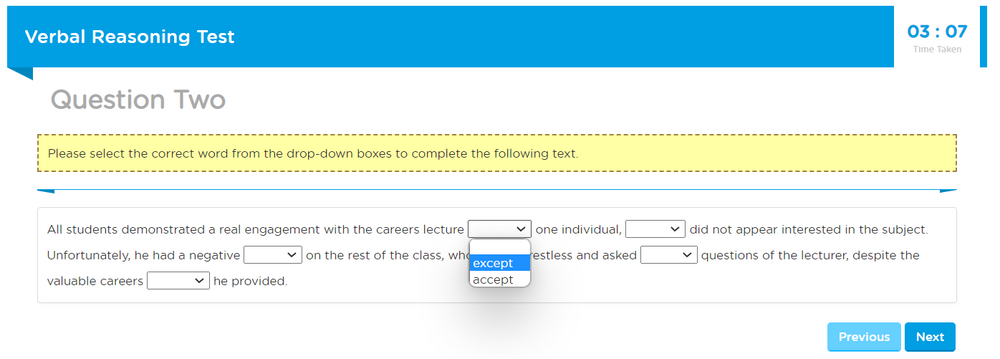
Question
All students demonstrated a real engagement with the careers lecture ________(except/accept) one individual.
Answer:
Except: not including, but not
Accept: to agree to take something or consider something satisfactory, reasonable, or accurate.
Based on the meaning, the correct answer must be Except (meaning: there is one individual who does not engage with the lecture).
Mistake correction
This exercise is quite close to some tasks at entry-level - proofreading. There will be a short written document, and you will have to click on the words/phrases with grammatical, spelling, and punctuation mistakes, then type in the correct answer. You must be able to detect all mistakes in the passage.
Example
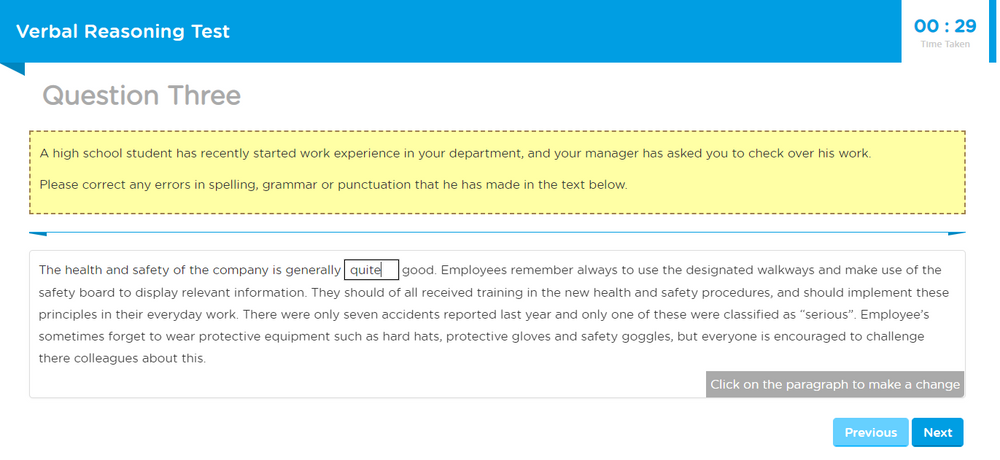
Find the errors in spelling, grammar, or punctuation.
Employees remember always to use the designated walkways and make use of the safety board to display relevant information.
Answer:
Employees always remember to use the designated walkways and make use of the safety board that displays relevant information.
Communication responses
This question type assesses how appropriately you facilitate communication in the workplace. You will have given message(s) written in two opposite styles, and your job is to match the answer with each style.
There are two formats for this question
- Drag-and-drop the responses to their corresponding messages based on two styles: formal and informal
- Rank the responses in the order from positive response to negative response.
Example (Drag-and-drop)
For each response below, please indicate which of the original messages it would best reply to, based entirely on the style of communication.
(1) Please find attached the final analyses. I hope this is valuable to aid with the decision-making process. If you require any additional support or information, please do let me know.
(2) Here's the latest copy of the analysis you wanted. Hope it comes in useful with your decision-making. Let me know if you guys need any help or info.
A. Thank you for your support and conscientiousness; your involvement in this project has been highly valued by the team.
B. Thanks for getting this finished off so quickly; I'm really pleased to have your support on the project. Great work.
C. I'm so glad you're working with us on this project with us - thanks! It's really great to have your support.
D. Many thanks for your continuing commitment; the analysis you have provided will allow us to make defensible decisions.
Answer: 1. A - D; 2. B - C
Explanation:
We can see that message (1) is written in formal writing styles (using more formal advanced vocabulary and more structured sentences). Meanwhile, message (2) is written in an informal/semi-formal writing style (the tone and word choices are more casual, and sentences are similar to spoken language). Therefore, we will categorize the answer accordingly.
We have answers B and C written in a tone similar to spoken language, while A and D are more of written language.
Example (Ranking)
You recently thought of a new idea linked to a project your colleagues are working on. You messaged them with your suggestion and justifications and have received the five replies below. Please rank these from most positive to least positive about your suggestion.
Answer:
1. D. Great idea - not like we haven't thought of this before. It's really helpful to have input from someone without experience after we've already made the decision.
2. C. Many thanks for your suggestion. As always, it is highly innovative, and your ability to think of unique ideas is unparalleled. However, due to a limited budget, we currently have no way of implementing this suggestion.
3. B - Great idea, but the timing is not good as we have already signed off the budget for the project as it is. I wish you'd told us earlier!
4. E. Thanks for your input, but I'm not convinced about this idea, especially now we have already made decisions on the project.
5. A - I appreciate your input but I really do feel like we would be better off leaving the project as it is.
Making inferences
These questions are in the form of a written passage and a range of statements. Your task is to decide whether each statement is True, False, or Cannot Say. To achieve a high score, you need to differentiate the meaning of each response.
- True – You can find the information in the passage that logically aligns with the statement.
- False – The information in the passage DOES NOT logically align with the statement
- Can’t Say – The information can not help you determine whether the statement logically aligns or not.
Example

All interns require supervision on the shop floor, and the shop floor consists of interns, team members and supervisors. Identification badges come in different colours, which represent different statuses within the team. Everyone that requires supervision wears a green badge, and all supervisors wear a blue badge.
Based only on this information you have been provided with, please select whether each statement is TRUE, FALSE or you CAN'T SAY.
A. Everyone who wears a green badge is an intern
B. Not all supervisors wear identification
C. All interns are required to wear identification.
D. Everyone who wears identification is an intern
E. All employees are required to wear identification
Answer:
A. Everyone who wears a green badge is an intern.
Can’t say. We only know all interns require supervision, which means they wear a green badge. There is no information to tell that all people wearing green badges are only interns.
B. Not all supervisors wear identification.
False. It states that “all supervisors wear a blue badge”
C. All interns are required to wear identification.
True. Intern requires supervision, and “Everyone that requires supervision wears a green badge”
D. Everyone who wears identification is an intern.
False. Supervisors also wear identification (badges)
E. All employees are required to wear identification.
Can’t say. We have no information about whether the team members wear identification or not.
Barclays critical reasoning test
Barclays Critical Reasoning Test is used as a precise and reliable measurement of the test taker's critical thinking, including analyzing, evaluating, interpreting, and deducing logical conclusions from a set of information.
The questions type of the Barclays Critical Reasoning Test is similar to Watson Glasser Critical Reasoning Test. It includes 5 types of Critical Reasoning questions, which are:

In this articles, we will introduce examples of each question type. If you want to understand the indepth of the Critical Reasoning Test, you can check our article on Watson Glasser Critical Reasoning Test.
Infer questions
This type of question provides you with a short passage (70-100 words) and a series of statements. Your task will be to determine whether each statement is True, Probably True, Can’t Say, Probably False, or False based on the information in the passage.
- True: Statement is adequately supported with evidence by the given information
- Probably True: Statement is more likely to be true than false
- Can’t say: Not enough information to conclude
- Probably False: Statement is more likely to be false than true
- False: Statement is not supported by/contradict to the given information.
Note: You should evaluate each statement SEPARATELY.
Example question
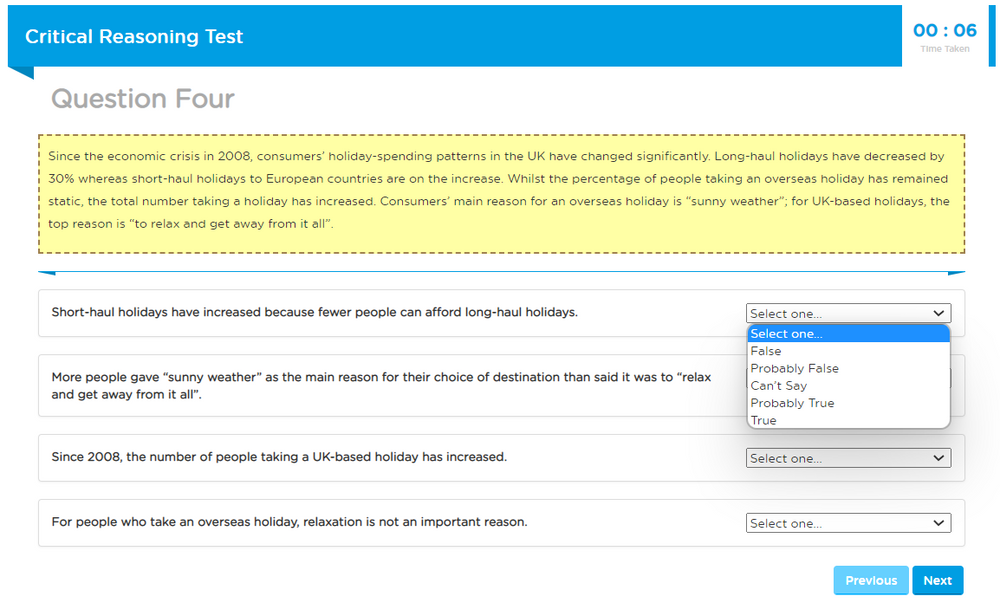
Since the economic crisis in 2008, consumers' holiday-spending patterns in the UK have changed significantly. Long-haul holidays have decreased by 30%, whereas short-haul holidays in European countries are on the increase. Whilst the percentage of people taking an overseas holiday has remained static, the total number taking a holiday has increased. Consumers' main reason for an overseas holiday is "sunny weather"; for UK-based holidays, the top reason is "to relax and get away from it all".
1. Short-haul holidays have increased because fewer people can afford long-haul holidays.
Answer:
The answer is Can’t say. There is no information in the passage mentioning that “fewer people can afford long-haul holidays”.
Recognize assumption questions
In this question, you will be given a short context (2-3 sentences) and 4 assumptions. Your job is to determine whether
- the statement is taken for granted or be accepted as justifiable, actual fact (Assumed), or
- the statement is not necessarily assumed to be true (Not assumed).
Note: You should evaluate each statement SEPARATELY.
Example
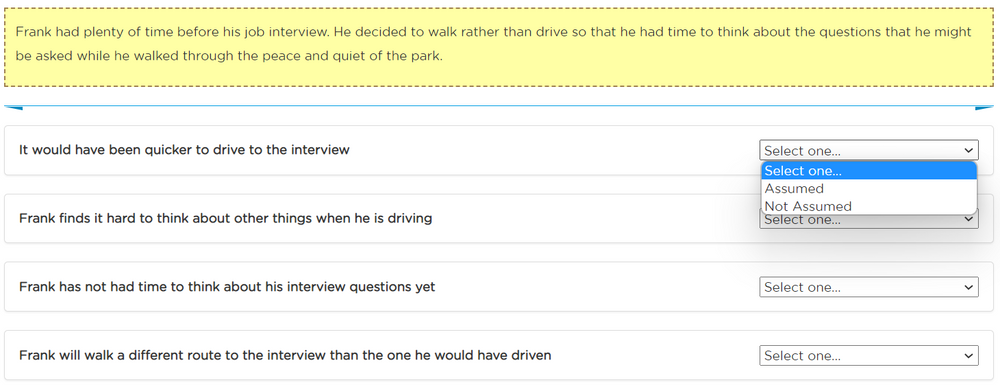
Frank had plenty of time before his job interview. He decided to walk rather than drive so that he had time to think about the questions that he might be asked while he walked through the peace and quiet of the park.
Assumption: It would have been quicker to drive to the interview.
Answer:
This assumption is made (Assumed) since he was buying more time by walking rather than driving; therefore, we can assume that driving takes less time and is a faster way to get to the interview.
Interpret question
The Interpret question type presents you with a short passage (3-4 sentences) and different conclusions. You will need to check whether the conclusion follows beyond a reasonable doubt from the provided information or not, i.e.:
- Conclusion follows: you can use provided information to reach a conclusion; the conclusion is not necessarily substantiated or derived fully from the given information.
- Conclusion does not follow: you can NOT use the provided information to reach the conclusion.
Note: You should evaluate each statement SEPARATELY.

Example:
Macrotronics Ltd was established in 1992 and now consists of 3 divisions: Telecoms, Consumables, and Infrastructure. After two years of trading, the Telecoms division became the first to be profitable and has maintained the highest profit margin. By 1998, Consumables and Infrastructure reached profitability - the latter having its peak in 2010 at 12%.
Conclusion: None of the divisions were profitable in 1992.
⇒ Conclusion follows. “After two years of trading, the Telecoms division became the first to be profitable” ⇒ from 1992 to 1994, no division was profitable (since the Telecom division was the FIRST to be profitable in 1994).
Evaluate Argument question
Evaluating Argument question starts with an argumentative question and a series of supporting arguments. Your task is to determine whether the argument is strong or weak.
- Strong argument is both important and directly related to the question.
- Weak argument is either of minor importance or is not directly related to the question (even if it is of general importance).
Note: You should evaluate each argument SEPARATELY.
Example

Should it be a legal requirement for manufacturers to reduce the amount of sugar in their soft drinks to improve health?
- No, because some confectionery and cakes have as much, if not more, sugar than soft drinks.
- Yes, because there is a positive association between the increasing size of soft drink portions, the sugar content, and childhood obesity rates.
Answer:
Argument (1) is a weak argument since it is not directly related to the questions - the question focuses on the legal requirement for sugar reduction in soft drinks. Still, the argument presents ideas about other products.
Argument (2) is a strong argument since it is an important point to say “yes” to the question and is directly related to the question - it shows the evidence (association between sugar content to childhood obesity rates) to support the argument that there should be a legal requirement to sugar reduction in the soft drink.
Deduction questions
This type is easily confused with Interpret Question because they have a similar format: it presents a short passage followed by several statements. Also, it asks you to determine whether a conclusion follows or does not follow. However, the differences are
- Conclusion follows: the statement can be fully substantiated/derived from the given information.
- Conclusion does not follow: the statement is not necessarily substantiated/derived from the given information.
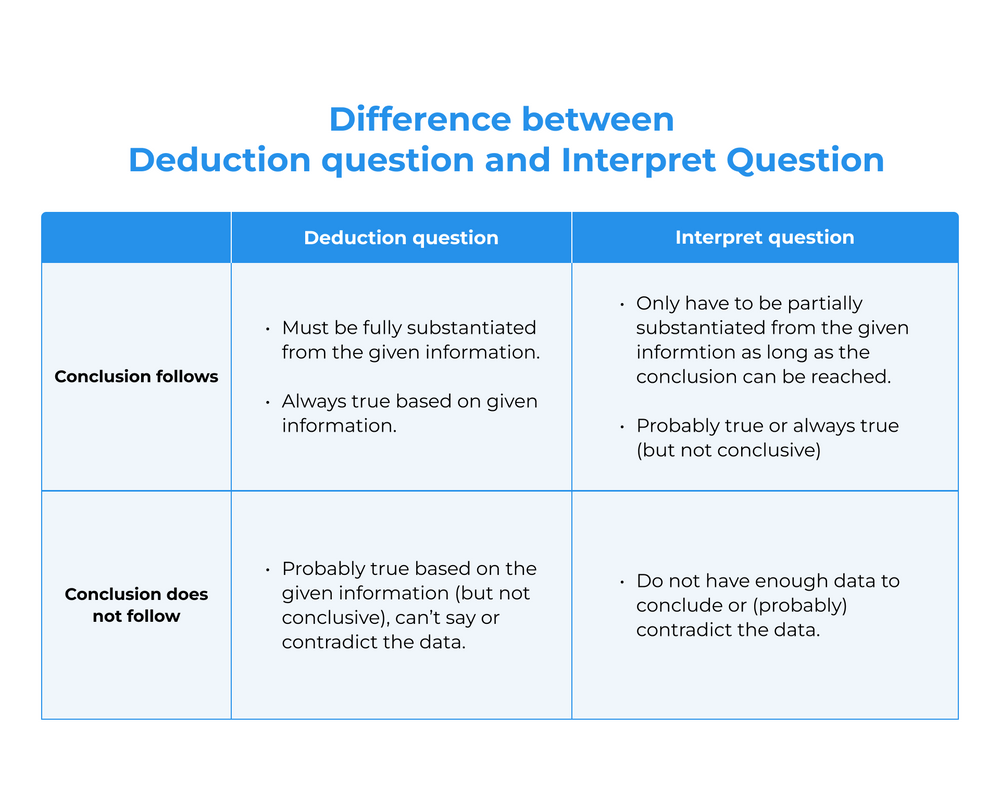
You should bear this difference in mind to be able to choose the correct answer.
Note: You should evaluate each statement SEPARATELY.
Example
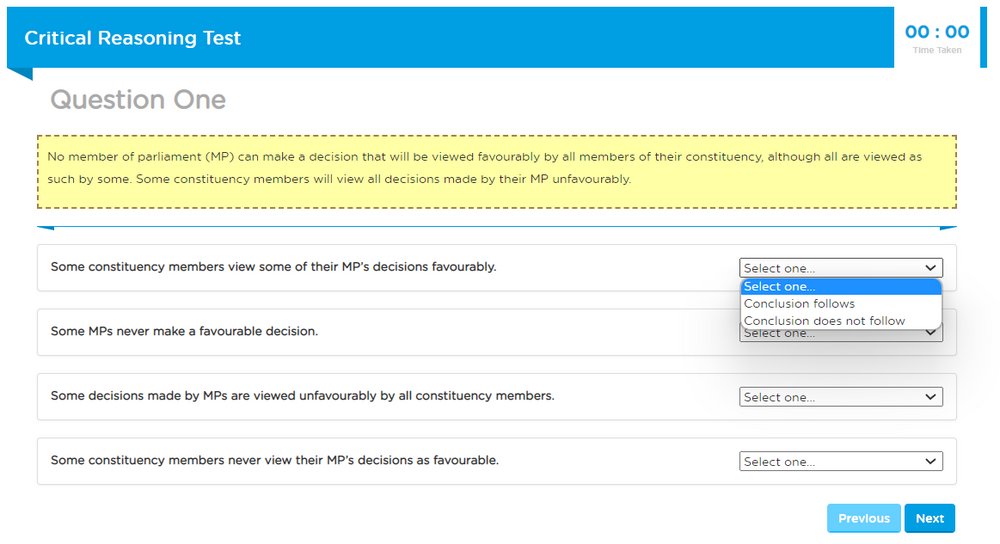
No member of parliament (MP) can make a decision that will be viewed favourably by all members of their constituency, although all are viewed as such by some. Some constituency members will view all decisions made by their MP unfavourably.
- Some constituency members view some of their MP's decisions favourably.
- Some constituency members never view their MP's decisions as favourable.
Answer:
“all are viewed as such by some” ⇒ All MP’s decisions are viewed as favourably by at least one to all members of their constituency.
Conclusion (1): Some constituency members view some of their MP's decisions favourably ⇒ At least one to all constituency members view some of their MP's decisions favourably. ⇒ This conclusion follows.
Conclusion (2): Some constituency members never view their MP's decisions as favourable. ⇒ At least one to all constituency members never view some of their MP's decisions favourably. ⇒ The given information is not enough to conclude whether this statement is always true or not. ⇒ Conclusion does not follow.
Barclays situational judgement test
The Situational Judgement Test is designed to understand your behaviors and strengths in work performance. You will be presented with a workplace situation and 4 to 5 reactions or responses. Your job is to rank the options in order of what you are most likely to do to least likely to do. There is no right or wrong answer.
The test is not scored but to know about your working styles and how you will fit in the culture. The employers seek consistency in your answer. Therefore, you should answer based on your nature to have a consistent result for this test.
Example
It's 8 am, and you arrive for your shift as a customer service advisor. You soon find out that a number of your colleagues have called in sick today. This means you will have a much higher number of calls to answer, and customers will likely be annoyed by the extra waiting time. It is only your second week at work.
How do you feel?
From the list below, please rank the option from what you would most likely feel to what you would least likely feel
A. Challenged. You know your customers may be angry about having to wait, and speaking to them will be difficult for you.
B. Pragmatic. You know there is little you can do about the situation, so expect some angry customers.
C. Uncertain. You know it will be a difficult day, and hope your performance is not affected.
D. Focused. You concentrate on working as well as you can under the circumstances.
E. Determined. You know it will be a difficult day, but it is important you remain calm and upbeat for your customers.
Tips to pass Barclays online assessment
Improve your test accuracy
Practice beforehand: There are a lot of different tests and questions to solve in the online assessment of Barclays. It would help if you familiarized yourself with each test in advance. You can practice with each question type and take mock tests to improve accuracy.
Read the scenario and response options carefully: Since Barclays online assessment is not timed. Take your time to fully understand what the question is asking you to maximize your score.
Stay focused during the test
The test will be around 60 to 90 minutes long, and you will have to shift between 4 different tests, which is quite mentally demanding. Try to take the online assessment in a place where you feel comfortable with a stable internet connection. You can also use headphones to block noises and tell others not to interrupt you during the test.
Align yourself with Barclays values with honesty
Be honest and authentic. When choosing your response, think about how you would behave in that scenario. What would your natural reaction be?
Don’t choose the answer based on what you think Barclays ‘wants’ you to say. The purpose of these assessments is to understand your natural Strengths. And the test will also check for consistency among your answers. Employers will fail any candidate who tries to act up their personality and shows inconsistent answers.
FAQs
What score do I need to pass Barclays Online Assessment?
The test score will be based on how you perform in all tests regarding your accuracy and speed. A safe range for you is around the highest 20% among all candidates.
How much time does the Barclays online assessment take?
Barclays aptitude tests are NOT timed. However, the time is recorded, then combined with your accuracy rate while taking the test to evaluate your performance. A candidate normally spends 60-90 minutes finishing the whole Barclays aptitude series.
What core values do Barclays recruiters expect from candidates?
Barclays has 5 core values that every employee should own in their personality and work performance:
- Stewardship – Barclays expects employees to help in the company's development and to be better tomorrow than today.
- Respect – All employees should value the contribution of everyone else on the team.
- Service – Employees should strive to put the company’s clients first.
- Excellence – Employees are expected to give their absolute best to ensure they deliver the most they can at any given time.
- Integrity – Employees should strive to be honest in all their activities. This is especially important in the financial industry as clients must trust employees to manage their finances.
What are the competencies that Barclays look for?
It would be best if you tried to demonstrate a few competencies throughout the Barclays assessment to show that you are the perfect candidate:
- Leadership skills: Developing others and enabling high performance.
- Leads by example, builds strong relationships and motivates and inspires people.
- Takes accountability for own development and supports others through sharing knowledge and honest two-way feedback - Business skills: Driving continuous improvement and innovation, defining and executing change & commercial decision-making
- Applying analytical reasoning and judgment to solve problems
- Employing appropriate resources to drive continuous improvement and innovation.
- Makes informed, transparent decisions and considers the broader implications.
- Takes ownership of decisions that impact your area. - Interpersonal skills:
- Building self-insight
- Building relationships
- Working collaboratively. - Control Environment:
- Proactively identifies and monitors risk.
- Takes accountability for mitigation by understanding risk drivers, escalation, and careful adherence to the bank’s policies, procedures, and practices.
/filters:quality(75)//case_thumb/public/1699589977462_aptitude_tests_package_4_x.png)